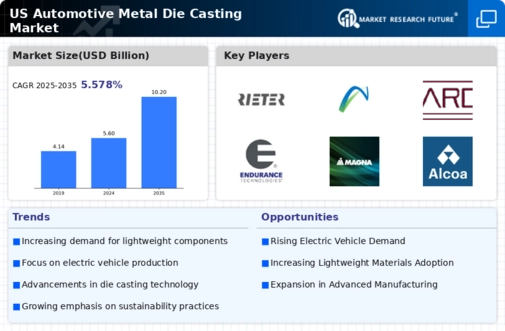The automotive metal die casting market is characterized by a competitive landscape that is increasingly shaped by innovation, sustainability, and strategic partnerships. Key players such as Alcoa Corporation (US), Magna International Inc. (CA), and AAM (US) are actively pursuing strategies that emphasize technological advancements and operational efficiencies. Alcoa Corporation (US) has focused on enhancing its aluminum casting capabilities, which aligns with the growing demand for lightweight materials in automotive applications. Meanwhile, Magna International Inc. (CA) has been expanding its footprint through strategic acquisitions, thereby bolstering its production capacity and diversifying its product offerings. AAM (US) appears to be concentrating on digital transformation initiatives, which may enhance its manufacturing processes and supply chain management, thereby positioning itself favorably in a competitive environment.
The market structure is moderately fragmented, with numerous players vying for market share. Key business tactics such as localizing manufacturing and optimizing supply chains are prevalent among leading companies. This approach not only reduces operational costs but also enhances responsiveness to regional market demands. The collective influence of these key players contributes to a dynamic competitive environment, where agility and innovation are paramount.
In November 2025, Alcoa Corporation (US) announced a partnership with a leading electric vehicle manufacturer to supply advanced aluminum die castings. This strategic move is significant as it aligns with the automotive industry's shift towards electrification, potentially positioning Alcoa as a key supplier in a rapidly evolving market. The partnership may also enhance Alcoa's reputation for sustainability, as aluminum is increasingly recognized for its recyclability and lightweight properties.
In October 2025, Magna International Inc. (CA) completed the acquisition of a regional die casting firm, which is expected to enhance its production capabilities and expand its customer base. This acquisition reflects Magna's strategy to consolidate its market position and leverage synergies that could lead to improved operational efficiencies. The integration of the acquired firm may also facilitate the introduction of innovative die casting technologies, further strengthening Magna's competitive edge.
In September 2025, AAM (US) launched a new digital platform aimed at optimizing its die casting operations. This initiative is indicative of AAM's commitment to digital transformation, which could lead to enhanced productivity and reduced lead times. By investing in technology, AAM is likely positioning itself to meet the increasing demands for precision and efficiency in die casting processes, thereby reinforcing its market presence.
As of December 2025, current competitive trends in the automotive metal die casting market are heavily influenced by digitalization, sustainability, and the integration of artificial intelligence (AI). Strategic alliances are becoming increasingly important, as companies seek to leverage complementary strengths to enhance their market offerings. The competitive landscape is shifting from traditional price-based competition to a focus on innovation, technology, and supply chain reliability. This evolution suggests that companies that prioritize these aspects will likely achieve greater differentiation and success in the future.


















Leave a Comment